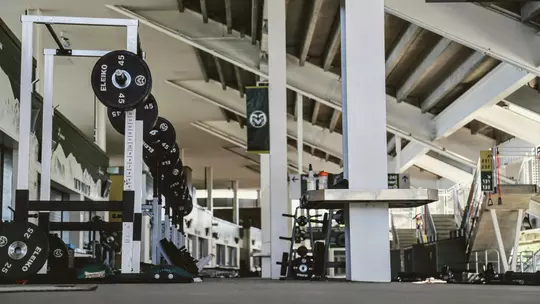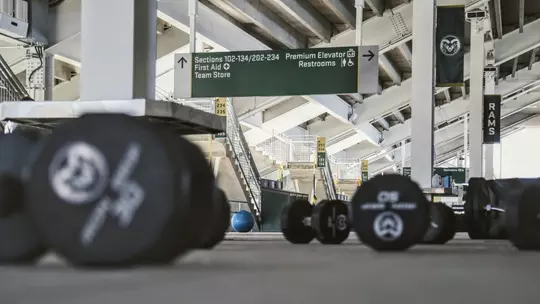
Athletic Department Pleased With Coronavirus Approach
With no positive tests, CSU braces for the inevitable
Mike Brohard
FORT COLLINS, Colo. – The odds are not in their favor.
Colorado State’s athletic department is very well aware of this fact in the coronavirus outbreak. In phases through the month of June, the football team checked in with nary a positive result coming from coronavirus testing. Some student-athletes from the men’s basketball and women’s volleyball team did the same this week – 127 in all to this point – all negative. On Monday, more will test as members of the women’s basketball and soccer teams move through the process.
It’s been a good run, knock on wood. But it would be folly to think one positive result isn’t coming.
“Absolutely. That’s a great thing,” said Terry DeZeeuw, CSU’s senior associate athletic director for health and performance. “The reality is, we fully expect to have some positive tests. The reality in what we’re dealing with now with COVID-19 is there are positives, and we’ve seen it around the country. Certainly we don’t have an expectation we won’t have one, but more importantly as we look at our protocols and policies, how can you identify them, manage them and limit the spread? That becomes really important, and that’s where our focus has been.”
Accepting the reality is part of the equation, but it doesn’t mean the athletic department isn’t doing all it can to fight the inevitable. The goal is to limit the number of positive tests, each one of which will cause a ripple effect.
If one player tests positive, it’s not just the individual who is quarantined. It becomes who else is in their workout group, the teammates who are their roommates. With the Fourth of July holiday weekend upon them, restressing the educational component is as important as the first day when student-athletes arrived back on campus.
Education took place before the student-athletes arrived, and reeducating remains just as important. As protected as they are on campus, DeZeeuw and his staff stress the preventative protections to follow as they depart.
Make no mistake, the student-athletes are as invested in the process as anybody.
“I feel like the university and our football program are doing the best they can to keep us protected. It’s the Fourth weekend, so some of us want to go out and do something different, because we have a three-day weekend,” senior football player Ellison Hubbard said. “The thing is, if they do go out and do something different, our athletic department, regardless of what you do, you might have to stay in for seven days just in case to stay away from shutting down this program. The university is doing the best they can to keep us safe. They want to have that protection for each player on the team.
“For the most part we are. We haven’t had anyone test positive, and we’ve been going strong for three, four weeks now. I think we’re doing our part to stay away from parties and any of those social gatherings. We stay at home, and if we need to go somewhere, we’re doing what we’ve been asked to do. I think we’re giving it our best shot to stay away from anything like that.”

We’ll be tested. That’s the one thing we keep reminding ourselves. It’s pervasive and a highly contagious virus, and we’re doing everything we can, but we know there will be a time when we’re going to deal with the impacts it has.Joe Parker, Director of Athletics
The successes Colorado State has experienced so far are due in large part to the work of DeZeeuw, according to CSU director of athletics Joe Parker. He stressed it has been a collaborative effort on campus with the pandemic team, as well as health partners UCHealth and Orthopaedic & Spine Center of the Rockies. The health screenings being done this year are more intensive because of the pandemic, DeZeeuw said.
“Like so many things we do, it’s been a highly collaborative process and efforts, and relying on our own expertise within our own university,” Parker said. “When you have a Tier 1 research institution, there’s no lack of information and expertise you can draw upon. That’s been extremely helpful, and I can’t underscore hard enough the values of someone like Terry DeZeeuw on our staff. He has a wonderful approach to everything he does, and he operates from a strong base of knowledge.”
The fact the plan so far has worked is encouraging for moving forward. Football has been isolated at Canvas Stadium, with the concourse becoming the weight room, and social distancing is a breeze for conditioning on the playing surface and adjacent practice fields. With the introduction of arena sports, some of the same plans remain in place, but other precautions become necessary. Soccer being outdoors is helpful, but the team will also use the same weight room as the basketball and volleyball teams.
“We’ve been able to really nail down the process and identify the things that are maybe challenges and things that are going to take a little bit more time and things we thought were going to go smoothly,” DeZeeuw said. “We’ve been able to reassess those. With the arena sports, certainly it’s a different dynamic. You’ve got multiple sports vying for single facilities versus Canvas Stadium, where we have a wide-open facility.
“It certainly changes the dynamics, and there are some logistical factors we’ve had to consider that are different than football. As we get going officially with that phase of it next week, I’m sure we’ll learn a few things and make a tweak to the plan, but conceptually, the things we put in place for football are carried over and we’re planning on using the same model over at the arena sports.”
Scheduling the teams is key, he said, not just for practice time but for the weight room in particular. Keeping groups small and spacing them out will aid the process of keeping equipment sanitized and safe.
The idea of getting back to work has invigorated student-athletes, even in the middle of a pandemic. The notion of being cautious and not being overly stressed has not always been easy to navigate. The risks and rewards have all been detailed.
“It’s not something we can completely prevent. Worrying about it too much past the point of being smart and trying to do everything we can to prevent it isn’t going to really help us a whole lot,” senior volleyball libero Alexa Roumeliotis said. “It’s trying to minimize the probability of it happening, but at the same time, not canceling our entire season or school year because of it. It’s something we’re definitely taking into consideration as we all get back on campus.
“I’m really excited about it. I think we all like playing volleyball and have missed it. Just getting back on the court and getting back to our daily routine of it will be nice for us.”
Quarantine fatigue has become all too real to many around the world, and DeZeeuw has found opening up a sport to the student-athletes has helped alleviate some of what they were feeling. Getting out of the house to work out has been a needed step mentally as much as physically for them, so they are more encouraged to remain vigilant in health practices once they leave.
Hubbard lives with three other teammates – Marcus McElroy, A’Jon Vivens and Livingston Paogofie. Like many of their peers, they’ve had their fill of Call of Duty and Fortnite. They’ve ridden their bikes and skateboards on their street to get outside. They’ve even resorted to board games – rarely, Hubbard said – to pass the time.
When the urge hits to do something more, the promise of a fall season keeps them alert.
“I go back and forth with it. Sometimes I go, ‘I want to go out, I’m tired of sitting in the house, it’s boring, it’s gloomy.’ There are times I’m like, this is my senior year, this is my last season, I don’t know what will happen if there is no season,” Hubbard said. “I’m doing the best I can to stay in this house, stay quarantined, stay away from catching COVID-19. I want to have that senior season, and I want other seniors on other teams to have their season, as well.”
Colorado State’s universal campus approach has proven effective, as have weekly meetings between Mountain West athletic directors, where successes have been shared to be practiced by the whole. Those talks extend to others in collegiate sports, as everyone involved is taking advantage of all information to be shared.
The phasing in approach has worked for Colorado State, and the lessons learned in the past month will be continued forward. As the indoor teams move into place, DeZeeuw expects more will be gleaned from the process as the athletic department brings all 16 programs into the fold over time.

“We’ll be tested,” Parker said. “That’s the one thing we keep reminding ourselves. It’s pervasive and a highly contagious virus, and we’re doing everything we can, but we know there will be a time when we’re going to deal with the impacts it has.”
Which is what the university is focused on now, DeZeeuw said. There is no wait and see approach. As with the phasing in of teams, there are protocols in place for when the first positive test occurs.
“I think that’s the part. You can build really good plans and protocols, and I think we have a great plan,” DeZeeuw said. “We’ve worked really well with the university pandemic plan, and we have a lot of university resources and departmental resources to help support those in need. Again, I think the important thing is to identify it as early as you can and really contact trace and limit the potential spread.
“That’s what makes it hard. If you identify one person who has tested positive and they’ve been pretty much isolated or independent for the last week, that’s not as big of an issue if you have somebody who’s been in close contact with three, four or five teammates. That changes the dynamic.”
Parker said the athletic department will follow all the health-reporting regulations when the time occurs, adding the department will be transparent with what is happening with student-athlete testing results.
A positive to DeZeeuw is the area around Colorado State. Larimer County has not been as greatly impacted by the virus as other parts of the country, which he believes traces back to the steps the county’s health experts took during the early stages. From May 19 through June 25, the county did not have a day with more than 10 reported cases, though three days since then have seen double digits, with a high of 15 on June 29, according to figures released on the Larimer County website.
As of now, Larimer County lists the risk score as “medium,” with 752 total cases and 29 deaths since coronavirus numbers have been tracked in March.
In the meantime, the message remains the same at Colorado State. While student-athletes are on campus, health measures are strictly in place. As they depart, it’s wear a mask, practice social distancing, wash your hands regularly and avoid large groups.
“I think in many ways they’ve modified their behavior,” Parker said. “They’re making appropriate choices to protect themselves and others in the community. I know it’s difficult. It’s not easy for a college student, a young person to understand the impacts.
“I think they understand there are people around them that care about them, whether it’s family, coaches or people who have been helpful in their lives. They’re putting it all together, but we’re always constantly reminding and educated them of that.”
